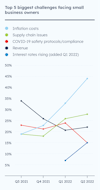Published
June 29, 2022
This quarter, the MetLife and U.S. Chamber of Commerce Small Business Index celebrates five years of publication. As the Index celebrates this milestone, we look back at five years of small business trends, the major challenges small business leaders have faced, and how small businesses feel about the future.
The Small Business Index is a premier tracker of U.S. small business sentiment and perspectives. The Index reports are released on a quarterly basis and are compiled from 750 unique interviews with small business owners and operators. It delivers a comprehensive quantitative snapshot of the small business sector. Read the latest report here.
Small Business Highs and Lows
Despite a challenging economy, the current Small Business Index score reached a pandemic-era high of 66.8 this quarter. This is slightly higher than last quarter’s score of 64.1.
Of course, this quarter’s score is still some way from the all-time high. That score, 71.7, was recorded in Q1 2020, just before the COVID pandemic began (the survey that quarter was conducted in January 2020, before any significant shutdowns in the United States).

The low point for the Index was reached just one quarter later, Q2 2020, when the score reached 39.5. This also coincided with the first full quarter in which major shutdowns began in response to the pandemic. Since then, the index has slowly gained ground despite a significant step back when the Delta variant of COVID-19 emerged in mid-2021.
Small Business Owners Are Working Harder
Over the last five years, one key finding stands out: in a post-pandemic world with major labor shortages, small business owners report working longer hours than they used to.
In fact, half (50%) of small business owners say they are working more hours now than they were a year ago. This question was first asked in the inaugural SBI (Q2 2017). Five years ago, 30% said they were working more hours. This equates to a very significant 20-percentage point increase in the share of small business owners that report working more hours.
Small Business Access to Capital Less than ‘Very Good’
Generally, small businesses today consider the quality of their access to capital as worse than five years ago. In 2022, more small business owners say their access to capital is simply “good” as opposed to “very good” compared to when we first asked the question in 2017. More are also saying their access to capital is simply “fair.”
Today, 40% report having good access to capital or loans, while another 14% indicate they have very good access. This represents a stark decline in the share of small businesses that rate their access to capital as very good (14% vs. 33%) compared to when we first asked this question in our inaugural SBI (Q2 2017).
Meanwhile, 26% now see their access to capital as fair, up from 14% saying the same in 2017.
In 2022, Inflation Concerns Dominate
This quarter, small businesses say inflation is, by far, their top concern. Forty-four percent of the small businesses surveyed cite inflation as the biggest challenge facing small business owners, up from 33% last quarter. This is up significantly from 19% when the question was first asked in Q3 2021. Furthermore, nearly nine in ten (88%) are concerned about the impact of inflation on their business, with almost half (49%) indicating they are very concerned (up from 44% in Q1 2022 and 31% in Q4 2021).

To keep up, many small businesses report raising the prices they charge customers. A strong majority (69%) of small businesses surveyed report raising the prices of their products or services due to inflation in the past year. This is consistent with the 67% that reported raising their prices due to inflation last quarter. Nearly half (46%) report having taken out a loan to cover higher costs due to inflation (up from 39% in Q1 2022).
An Enduring Trend—Small Business Is Resilient and Optimistic
One striking thing about small business owners over the past five years has been their steady optimism that things will improve in the future no matter what challenges the present throws at them. And this quarter is no different.
Looking ahead to next year, 43% of small businesses intend to increase their staff—an increase of six percentage points from last quarter. Meanwhile, 43% anticipate they will invest more over the next year, and 66% expect revenues to increase, both on par with Q1 2022.
It takes a lot of grit, determination, and hard work to start and sustain any small business. If anything, the SBI over the past five years has demonstrated small business leaders also have something else that sets them apart: relentless optimism.
For more findings from this quarter,and to explore and browse years of small business data, visit: https://www.uschamber.com/sbindex/.
About the author

Thaddeus Swanek
Thaddeus is a senior writer and editor with the U.S. Chamber of Commerce's strategic communications team.





